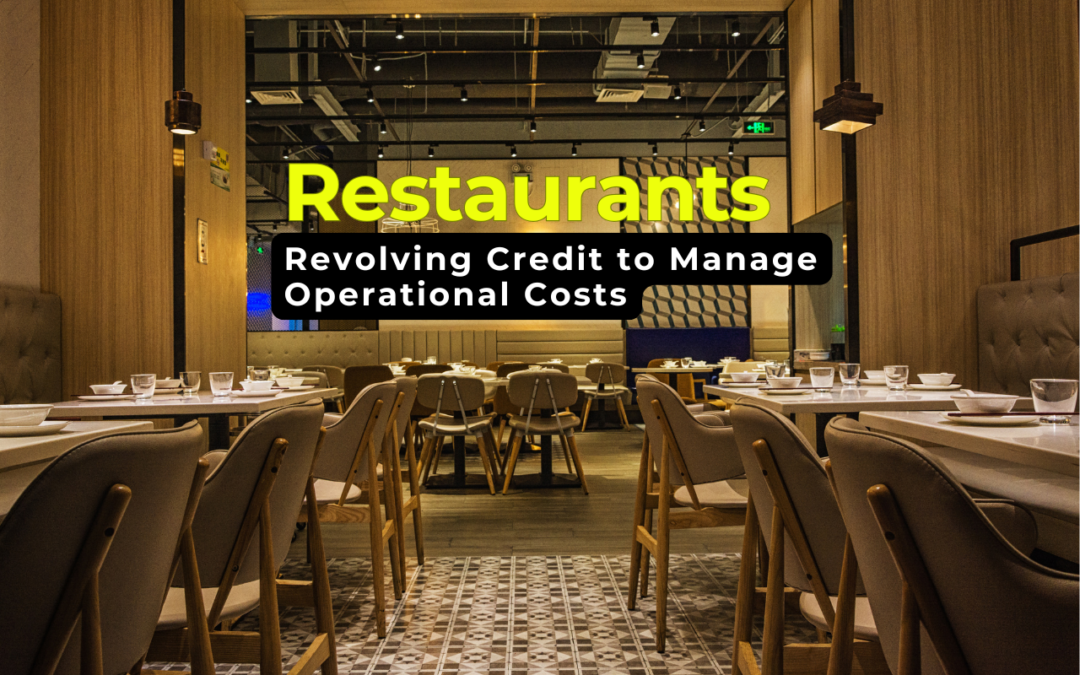Running a restaurant comes with its fair share of financial challenges. From inventory purchases and payroll to utility bills and unexpected expenses, managing operational costs efficiently is key to long-term success. One financial tool that can provide flexibility and stability is revolving credit. This article explores how restaurants can use revolving credit to manage their expenses and maintain financial health.
Understanding Revolving Credit
Revolving credit is a type of credit line that allows businesses to borrow, repay, and borrow again up to a set credit limit. Unlike traditional loans, which provide a lump sum upfront, revolving credit gives restaurant owners access to funds as needed, making it an ideal financial solution for managing fluctuating expenses.
Key Features of Revolving Credit:
- Flexible Access to Funds: Borrow as needed and repay on your terms.
- Only Pay for What You Use: Interest is charged only on the amount withdrawn.
- Continuous Credit Availability: Once repaid, the funds become available again.
- Higher Cash Flow Management: Helps smooth out seasonal or unexpected expenses.
How Restaurants Can Leverage Revolving Credit
1. Managing Inventory Costs
Restaurants need to purchase fresh ingredients, beverages, and other supplies regularly. With fluctuating food prices and bulk purchasing requirements, revolving credit can help cover these costs without straining cash flow.
Bulk Purchasing Advantages
Buying in bulk can significantly reduce costs per unit, but it requires upfront capital. With revolving credit, restaurants can purchase larger quantities of essential ingredients at discounted rates, ensuring long-term savings.
Dealing with Supplier Payment Terms
Many suppliers require upfront payments or have strict payment terms. Revolving credit allows restaurant owners to make timely payments and maintain strong supplier relationships.
2. Handling Payroll and Staffing Expenses
Labor costs are one of the highest expenses for restaurants. Whether it’s paying hourly workers, hiring seasonal staff, or covering payroll gaps during slow periods, revolving credit ensures staff salaries are covered on time.
Seasonal Hiring Needs
During holiday seasons or special events, restaurants often need additional staff. Using revolving credit allows restaurant owners to hire temporary staff without disrupting cash flow.
Retaining Top Talent
Competitive salaries and timely payments help retain experienced chefs, servers, and managers. With revolving credit, restaurants can ensure payroll obligations are met without financial strain.
3. Covering Unexpected Repairs and Maintenance
Kitchen equipment and restaurant facilities require regular maintenance and sometimes emergency repairs. Instead of dipping into emergency savings or disrupting operations, restaurants can use revolving credit to address urgent repairs immediately.
Common Equipment Failures
- Refrigeration system breakdowns can lead to food spoilage.
- Stove or oven failures can halt food preparation.
- POS system issues can disrupt order management and billing.
Having access to revolving credit means that restaurant owners can handle these issues promptly, reducing downtime and revenue losses.
4. Investing in Marketing and Promotions
To attract new customers and retain existing ones, restaurants need to invest in marketing campaigns, social media ads, and seasonal promotions. A revolving credit line provides funds to execute effective marketing strategies without affecting daily operations.
Digital Marketing Strategies
- Running targeted ads on social media platforms like Instagram and Facebook.
- Investing in search engine optimization (SEO) to attract local customers.
- Partnering with food influencers and bloggers to promote special dishes.
5. Smoothing Out Seasonal Fluctuations
Many restaurants experience seasonal peaks and slow periods. A revolving credit line helps bridge revenue gaps, ensuring businesses can maintain smooth operations during low seasons.
Examples of Seasonal Variations
- Coastal restaurants may see reduced traffic during colder months.
- Holiday seasons bring in high demand, but require extra inventory and staff.
- Restaurants in business districts may experience lower footfall during holidays or vacation periods.
With revolving credit, restaurants can prepare for these fluctuations and maintain operations smoothly.
6. Expanding or Upgrading the Business
Revolving credit can support business growth, such as remodeling dining areas, upgrading technology (POS systems, online ordering), or adding new menu items. This enables restaurants to stay competitive without waiting for revenue to accumulate.
Technology Upgrades
- Investing in contactless payment systems to enhance customer convenience.
- Implementing automated inventory management tools to reduce waste.
- Upgrading online ordering platforms to boost delivery and takeout sales.
Restaurant Renovations
- Modernizing interior design to attract more customers.
- Expanding seating capacity to accommodate larger groups.
- Installing energy-efficient appliances to reduce operational costs.
Case Studies: Real-Life Applications of Revolving Credit in Restaurants
Case Study 1: A Small Bistro Navigates Seasonal Challenges
A small bistro in a tourist-heavy area faced challenges during the off-season when foot traffic dropped. By using revolving credit, the owners maintained payroll, launched an aggressive online marketing campaign, and kept the restaurant running until the peak season returned.
Case Study 2: Fast Food Chain Expands Digital Presence
A fast-food franchise utilized revolving credit to revamp its website and implement an app-based ordering system. The investment increased online orders by 40%, leading to sustained revenue growth.
Case Study 3: Emergency Equipment Repairs in a Fine Dining Restaurant
A high-end restaurant experienced an unexpected refrigeration failure. Using revolving credit, the owner was able to secure quick repairs, preventing thousands of dollars in losses from spoiled inventory.
Best Practices for Using Revolving Credit Wisely
1. Borrow Only What You Need
Avoid unnecessary debt by withdrawing only the required amount to cover expenses.
2. Monitor Interest Rates
Stay informed about interest rates and repayment terms to minimize costs.
3. Repay Quickly
To avoid accumulating high interest, aim to pay off balances as soon as possible.
4. Use for Essential Expenses
Prioritize spending on crucial operational needs rather than non-essential purchases.
5. Maintain Good Credit Standing
Timely repayments can improve your business’s credit score, leading to better financing options in the future.
Common Misconceptions About Revolving Credit
Misconception 1: It Leads to Uncontrollable Debt
While revolving credit can lead to excessive debt if mismanaged, proper financial planning ensures that it remains a valuable tool rather than a liability.
Misconception 2: Only Large Restaurants Benefit from Revolving Credit
Small and medium-sized restaurants can equally benefit from revolving credit to cover inventory, payroll, and marketing expenses.
Misconception 3: It Should Be Used Only for Emergencies
While revolving credit is useful for emergencies, it can also be used proactively for business growth and expansion.
Conclusion
Revolving credit is a powerful financial tool that restaurants can use to manage operational costs effectively. By providing flexible access to funds, it helps restaurants maintain smooth cash flow, cover expenses, and invest in growth opportunities. When used responsibly, revolving credit can be a game-changer in the highly competitive restaurant industry, ensuring financial stability and long-term success.
By understanding how to leverage revolving credit strategically, restaurant owners can turn financial challenges into opportunities, keeping their businesses thriving even in uncertain times. Whether it’s managing seasonal fluctuations, handling urgent repairs, or investing in marketing, revolving credit offers the flexibility that restaurants need to stay ahead of the competition.












